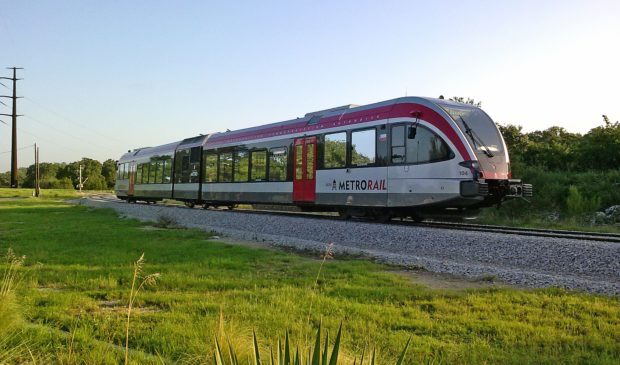For game-changing public transit, Austin needs the feds to chip in
Tuesday, August 7, 2018 by
Jack Craver Austin and the surrounding metro area needs a transportation game-changer, and it’s not going to come from more roads. And to build it, we’ll need some help from Washington, D.C.
That was the message that officials from Capital Metro delivered to a joint meeting on Monday of the Capital Metro board and City Council over Project Connect, the regional transportation agency’s long-term plan to build high-capacity public transportation, such as light rail or bus rapid transit.
“Only public transit can be a backbone of a multimodal system,” said Todd Hemingson, Capital Metro executive vice president of planning and development.
It’s much more difficult to “scale” car-based transportation to meet a growing population, Hemingson explained. It’s far easier to build upon a transit system to meet additional demand.
What Project Connect will entail remains unclear. In March, Capital Metro released a map that highlighted the corridors that it hopes to target for high-capacity transit, but it did not specify whether that would be rail, BRT, some other mode of transportation or a combination.
In December, Capital Metro staff will unveil an updated draft plan that specifically recommends certain modes for different corridors. The Capital Metro Board of Directors will vote on whether to approve the plan on Dec. 17.
Capital Metro CEO Randy Clarke stressed that the board’s approval will only be the first of many steps before shovels hit the ground. There are two other entities that need to buy into the plan: the local electorate and the federal government.
Capital Metro will have to convince voters, who shot down proposed rail bonds in 2000 and 2014, to approve a bond worth hundreds of millions of dollars.
Assuming voters approve a bond, however, the plan will still require significant funding from the federal government. Capital Metro is hoping that the feds can pick up half or more of the capital costs.
The good news for Capital Metro is that Congress has not gone along with the Trump administration’s attempts to reduce funding for the Federal Transit Administration, the agency that doles out billions in grants to local public transportation projects. The FAST Act, signed into law by President Barack Obama at the end of 2015, authorized $2.3 billion a year in funding for such projects through the 2020 fiscal year. Last year, Congress even approved upping the total for 2018 to $2.6 billion.
To get support from the FTA, Capital Metro has to convince federal officials that the project makes sense and that it can count on steady financial backing from local government.
“They’re not going to give us money if we can’t demonstrate that we can operate it on a sustainable basis,” said Hemingson.
Carolyn Flowers, a transit expert with AECOM, a national transportation consulting firm, also shared some insight from her time as an FTA official about which projects get funded. Funding for major projects typically comes in multiple phases, and there is a political element to which projects the FTA prioritizes, she said.
“During the process, if they see any sign of lack of support for the project, the project slows down,” she said. “Having the local support, the congressional support for the funding for your project, is really key.”
Council members stressed the need for Capital Metro to consider how it communicates about the project to the voters whose support it needs.
In 2014, said Council Member Leslie Pool, information about the proposed rail project “was not provided to the community in a very accurate manner.”
Council Member Ora Houston emphasized that Austinites cannot be expected to pick up the whole tab for a regional transportation system, saying that much of the city’s congestion problems are linked to commuters entering the city from surrounding towns.
“The property taxes in the city of Austin can only go up so much,” she said.
Capital Metro Board Chair Wade Cooper assured Houston that the board will be “very thoughtful about any financial ask that’s made of any particular partner.”
Council Member Jimmy Flannigan, echoing remarks he has made about those who opposed CodeNEXT, said that there will invariably be opposition to whatever plan is proposed by “people in the community who believe there’s some kind of magic bullet.”
People need to accept, said Flannigan, that investing in a high-quality public transit system will involve sacrifice, whether that is increased taxes, more land development or even more traffic.
Photo by Greg Houston [CC BY-SA 4.0 ], from Wikimedia Commons.
The Austin Monitor’s work is made possible by donations from the community. Though our reporting covers donors from time to time, we are careful to keep business and editorial efforts separate while maintaining transparency. A complete list of donors is available here, and our code of ethics is explained here.
You're a community leader
And we’re honored you look to us for serious, in-depth news. You know a strong community needs local and dedicated watchdog reporting. We’re here for you and that won’t change. Now will you take the powerful next step and support our nonprofit news organization?









